Return to the Light

Researching Isle Royale history over this past winter, often from the notes and files of my writer and publisher father-in-law, enhanced memories of my time in Washington Harbor last summer. Living and walking among the cabins, fish houses, and boat houses of Washington and Barnum Islands, boat trips to the Rock of Ages lighthouse, and visits to the site of the shipwreck America brought some of that history to life for me. It was so enjoyable, rewarding, refreshing (read: cool), and informative (thanks to descendants of the Sivertson fishing family), that I'm returning again as a volunteer this year. The Rock of Ages Lighthouse Preservation Society (ROALPS) was desperate enough to ask me to run the Rock Hopper workboat again to move supplies and work crews back and forth to the lighthouse for another season. Plans were to "Paint the Rock" this season. Over the winter, as part of their fundraising, I wrote a couple of articles to support publicity efforts. One, A Rock fo...




.jpeg)
